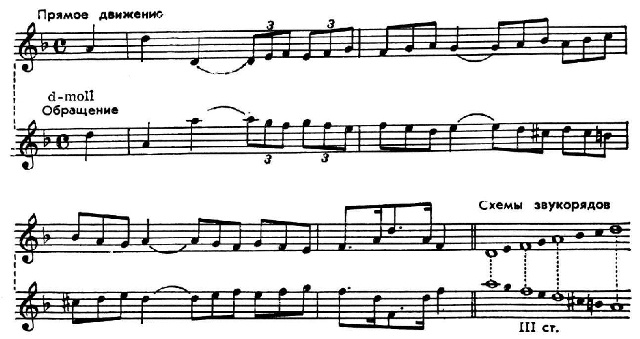
Topic circulation |
Topic reversal – countermovement, inversion (Latin inversio, Italian moto contrario, rovescio, riverso, rivoltato, French reversement, German die Umkehrung, die Gegenbewegung) – polyphonic. a technique for transforming a theme, which consists in playing its intervals in the opposite direction from a certain unchanging sound: the upward movement of the theme in its main (forward) movement (lat. motus rectus) in the reverse movement (lat. motus contrarius) corresponds to a move down the same interval ( and vice versa). The unchanging sound common to the theme in the main and inverted variants is called the axis of reversal; in principle, any stage can serve as it. In the major-minor tonal system, in order to preserve the functional similarity of both options, the third degree usually serves as the axis of circulation; in a strict style (14-16 centuries) with its naturally diatonic. frets reversal is often done around the third of a diminished triad, which ensures the same position of the sounds of the tritone:
 J. S. Bach. The Art of the Fugue, Counterpoint XIII.
J. S. Bach. The Art of the Fugue, Counterpoint XIII.
 Palestrina. Canonical Mass, Benedictus.
Palestrina. Canonical Mass, Benedictus.
In themes with chroma. O. movement of t. is carried out in such a way that, if possible, the qualitative value of the intervals is preserved – this ensures a greater similarity in the expressiveness of the reversed and direct movement:
 J. S. Bach. The Well-Tempered Clavier, Volume 1, Fugue fis-moll.
J. S. Bach. The Well-Tempered Clavier, Volume 1, Fugue fis-moll.
Techn. simplicity and art. The effectiveness of updating the theme through circulation determined the frequent and varied use of this technique, especially in monothematic works. There are varieties of fugue with an inverted answer (German Gegen-Fuge – see J. S. Bach, The Art of the Fugue, No 5, 6, 7) and a canon with an inverted rispost (W. A. Mozart, c-moll quintet, minuet); the appeal is used in the interludes of the fugue (Bach, The Well-Tempered Clavier, vol. 1, fugue in c-moll); a theme in circulation can give a stretta with a theme in direct motion (Mozart, fugue in g-moll, K.-V. 401); sometimes they just fit together (Mozart, fugue c-moll, K.-V., 426). Often large sections of compositions are based on O. t. (Bach, The Well-Tempered Clavier; vol. 1, fugue G-dur, counter-exposition; 2nd part of the gigue) and even entire forms (Bach, The Art of Fugue, No 12 , 13; R. K. Shchedrin, Polyphonic Notebook, No 7, 9). The combination of O. t. with other methods of transformation is particularly widespread in the music of the 20th century. (P. Hindemith, “Ludus tonalis”, cf. prelude and postlude), in particular, written using a serial technique (J.F. Stravinsky, “Agon”, Simple branle). As a means of variation and development, the appeal is used in non-polyphonic. music (S. S. Prokofiev, “Juliet-girl” from the ballet “Romeo and Juliet”), often in combination with a theme in direct movement (P. I. Tchaikovsky, 6th symphony, part 2, vol. 17- 24; S. S. Prokofiev, 4th sonata, part 2, vols. 25-28).
References: Zolotarev V. A., Fuga. Guide to practical study, M., 1932, 1965, section 13, Skrebkov S. S., Polyphonic analysis, M. – L., 1940, section 1, § 4; his own, Textbook of polyphony, parts 1-2, M. – L., 1951, M., 1965, § 11; Taneev S. I., Movable counterpoint of strict writing, M., 1959, p. 7-14; Bogatyrev S. S., Reversible counterpoint, M., 1960; Grigoriev S. S., Muller T. F., Textbook of polyphony, M., 1961, 1969, § 44; Dmitriev A.N., Polyphony as a factor of shaping, L., 1962, ch. 3; Yu. N. Tyulin, The Art of Counterpoint, M., 1964, ch. 3.
V. P. Frayonov



